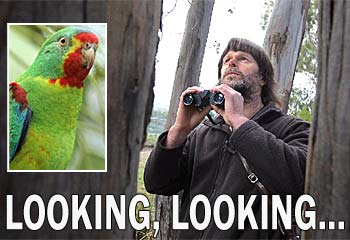 ON THE LOOKOUT ... Mt Nelson birdwatcher Andrew Hingston keeps a watch out for migrating swift parrots. He is encouraging other budding birdwatchers to report sightings of the endangered bird.BUDDING environmentalists and birdwatchers are being urged to report sightings of the endangered swift parrot this breeding season.
ON THE LOOKOUT ... Mt Nelson birdwatcher Andrew Hingston keeps a watch out for migrating swift parrots. He is encouraging other budding birdwatchers to report sightings of the endangered bird.BUDDING environmentalists and birdwatchers are being urged to report sightings of the endangered swift parrot this breeding season.
Mt Nelson resident Andrew Hingston, who has been involved in monitoring the bird for seven years, has already made a few sightings this month, including six birds last Wednesday.
He hopes this season will match the best season of 150 birds in a flock.
Residents of southeastern Tasmania are compiling sighting information for the swift parrot this year.
“Each year the return of this colourful little parrot is one of the harbingers of spring in Tasmania,” said Sharon East, a keen birdwatcher and spokeswoman for the South-East (Tas) Forest Protection Group.
“After completing their long annual migration from as far afield as South-East Queensland, swift parrots return to Tasmania to breed every year.”
They migrate to the mainland in February. There are only 1300 pairs which breed only in Tasmania, favouring forests in the coastal strip between Orford and Dover.
Ms East said much of the birds’ favoured nesting habitat was on land managed by Forestry Tasmania that was targeted for logging and woodchipping.
As the swift parrot was listed as nationally endangered under the federal Environment Protection and Biodiversity Conservation Act unless action was taken immediately, the species was likely to become extinct, she said.
People who spot swift parrots are asked to phone the South-East (Tas) Forest Protection Group on 6253 5348.
The parrots were commonly confused with the little or musk lorikeet, Ms East said.
The best way to identify a swift parrot is by its call—which tends to be pinging and bell-like when it flies out of trees and chattering when it is perched.
The musk lorikeet has a hard, rasping type of call and the little lorikeet has a soft, buzzing call.